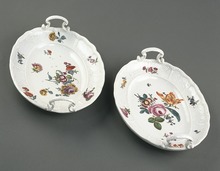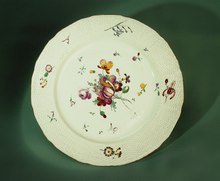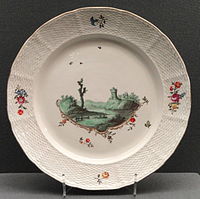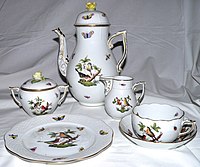180:
168:
17:
25:
156:
36:
195:
132:" ("ordinary osier") or Sulkowski type. It has small groups of shoots diagonal to the edge of the plate, forming squares with the adjacent groups at right angles. These are all set between straight vertical bands at regular intervals. The inner and outer boundaries of the osier decoration may be marked by striated bands, also imitating woven basketwork.
179:
144:
version with spiral ribs". In this type the vertical strips or ribs curve into a sort of "S" shape, are given more emphasis, and often come into the central well of the plate, projecting beyond the basket-weave, which may cover only about half of the raised border of the plate. The inner boundary of
135:
Not long after, a version was introduced with finer shoots, all going in the same direction parallel with the edge of the plate, and not always having the vertical strips, which as before are straight. After the final version was introduced in 1742, this second one was known as the "Altozier" or
167:
145:
the decoration is marked by a raised ridge. Both old and new types continued to be produced, up to the present day. The central well of the plate is left plain, except in the new type, and many larger pieces that are not flat (cups, pots and
123:
In fact
Meissen used three versions of the osier borders, with several minor variations between different moulds. The first type, produced from about 1732, and widely used in a dinner service for Count
120:
in the air, descending to join another on the left. The standing crane grasps a fish in his beak, and the head of another fish can be seen in the water beneath the swan on the right.
155:
16:
360:
100:
Such relief backgrounds were a speciality of
Meissen under Kändler, as in the "Dulong border" (from 1743) with a rather neoclassical
194:
336:
318:
300:
200:
365:
125:
355:
64:
185:
108:, where each plate or other piece of flatware has a delicate background with radiating bands based on a
28:
24:
329:
The
Wrightsman Collection. Vols. 3 and 4, Furniture, Snuffboxes, Silver, Bookbindings, Porcelain
340:
332:
322:
314:
296:
60:
304:
275:
69:
63:, and was later often imitated by other producers. It is presumed to have been devised by
35:
39:
A version of the third type "New Osier", known as "Brandenstein-Relief". Modern plate.
349:
112:
shell, against which there is in the central well a pair of swans on the water amid
117:
105:
101:
59:
plates and other pieces of flatware. It originated in
Germany in the 1730s on
90:
94:
56:
44:
20:
Two "osier pattern" dishes of the first "Sulkowski" type, Meissen, 1755–60
113:
161:
Lao ricebasket; the sort of weave imitated in the first "Sulkowski" type
173:
Wicker fence with the sort of weave imitated in the "old osier" pattern
109:
78:
136:"old ozier", and the third one as the "Neuozier" or "new osier". The
146:
141:
82:
52:
104:
pattern, and, most spectacular of all, the decoration of the famous
86:
34:
23:
15:
188:
imitation of the "old osier" pattern, with minimal vertical bands
31:
imitation of the "old osier" pattern, with minimal vertical bands
67:, the celebrated head modeller at Meissen. The name comes from
293:
The Art of
Ceramics: European Ceramic Design, 1500–1830
278:
has a diagram from a catalogue showing the three types.
311:
Land of the Winged
Horsemen: Art in Poland, 1572–1764
51:is a moulded basket-weave pattern in delicate
8:
309:Ostrowski, Jan K, DaCosta Kaufmann, Thomas,
89:were and are much used for various types of
214:
151:
149:for example) lack the relief pattern.
7:
331:, 1970, Metropolitan Museum of Art,
85:, whose thin, flexible, shoots or
14:
361:Individual patterns of tableware
327:"Wrightsman" (no author given),
193:
178:
166:
154:
313:, 1999, Yale University Press,
295:, 2001, Yale University Press,
257:Wrightsman, 122–124; Coutts, 95
128:of about 1735, is called the "
1:
221:Wrightsman, 124; Coutts, 95
203:set with the osier pattern.
382:
126:Alexander Joseph Sulkowski
55:used round the borders of
93:, usually encouraged by
73:, or the common osier (
65:Johann Joachim Kaendler
40:
32:
21:
186:Frankenthal porcelain
38:
29:Frankenthal porcelain
27:
19:
140:pattern was a "more
239:Wrightsman, 135–136
248:Ostrowski, 343–345
41:
33:
22:
366:Meissen porcelain
339:, 9780870990106,
321:, 9780300079180,
303:, 9780300083873,
61:Meissen porcelain
373:
356:German porcelain
291:Coutts, Howard,
279:
273:
267:
264:
258:
255:
249:
246:
240:
237:
231:
228:
222:
219:
201:Herend porcelain
197:
182:
170:
158:
381:
380:
376:
375:
374:
372:
371:
370:
346:
345:
288:
283:
282:
274:
270:
266:Wrightsman, 135
265:
261:
256:
252:
247:
243:
238:
234:
230:Wrightsman, 124
229:
225:
220:
216:
211:
204:
198:
189:
183:
174:
171:
162:
159:
70:Salix viminalis
12:
11:
5:
379:
377:
369:
368:
363:
358:
348:
347:
344:
343:
325:
307:
287:
284:
281:
280:
268:
259:
250:
241:
232:
223:
213:
212:
210:
207:
206:
205:
199:
192:
190:
184:
177:
175:
172:
165:
163:
160:
153:
77:in German), a
13:
10:
9:
6:
4:
3:
2:
378:
367:
364:
362:
359:
357:
354:
353:
351:
342:
338:
334:
330:
326:
324:
320:
316:
312:
308:
306:
302:
298:
294:
290:
289:
285:
277:
272:
269:
263:
260:
254:
251:
245:
242:
236:
233:
227:
224:
218:
215:
208:
202:
196:
191:
187:
181:
176:
169:
164:
157:
152:
150:
148:
143:
139:
133:
131:
130:ordinar ozier
127:
121:
119:
115:
111:
107:
103:
98:
96:
92:
88:
84:
80:
76:
72:
71:
66:
62:
58:
54:
50:
49:Osier pattern
46:
37:
30:
26:
18:
341:Google books
328:
323:google books
310:
305:google books
292:
271:
262:
253:
244:
235:
226:
217:
137:
134:
129:
122:
106:Swan Service
102:plant-scroll
99:
97:the plants.
74:
68:
48:
42:
81:species of
350:Categories
337:0870990101
319:0300079184
301:0300083874
286:References
276:Coutts, 95
114:bullrushes
91:wickerwork
95:coppicing
57:porcelain
45:tableware
138:Neuozier
116:, and a
79:Eurasian
147:tureens
110:scallop
87:withies
335:
317:
299:
142:rococo
83:willow
53:relief
209:Notes
118:crane
75:ozier
333:ISBN
315:ISBN
297:ISBN
47:the
43:In
352::
Text is available under the Creative Commons Attribution-ShareAlike License. Additional terms may apply.






